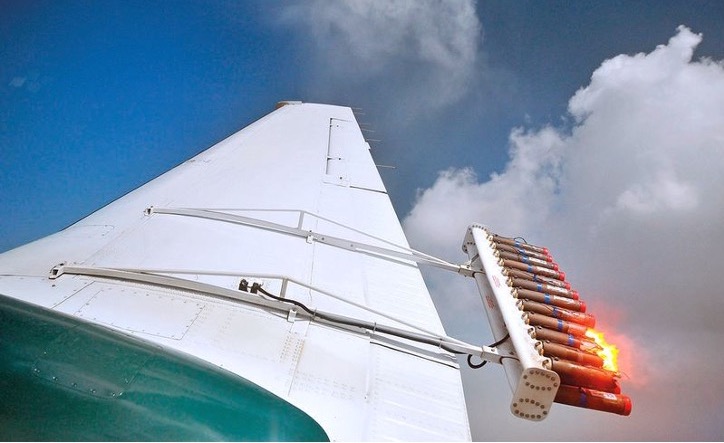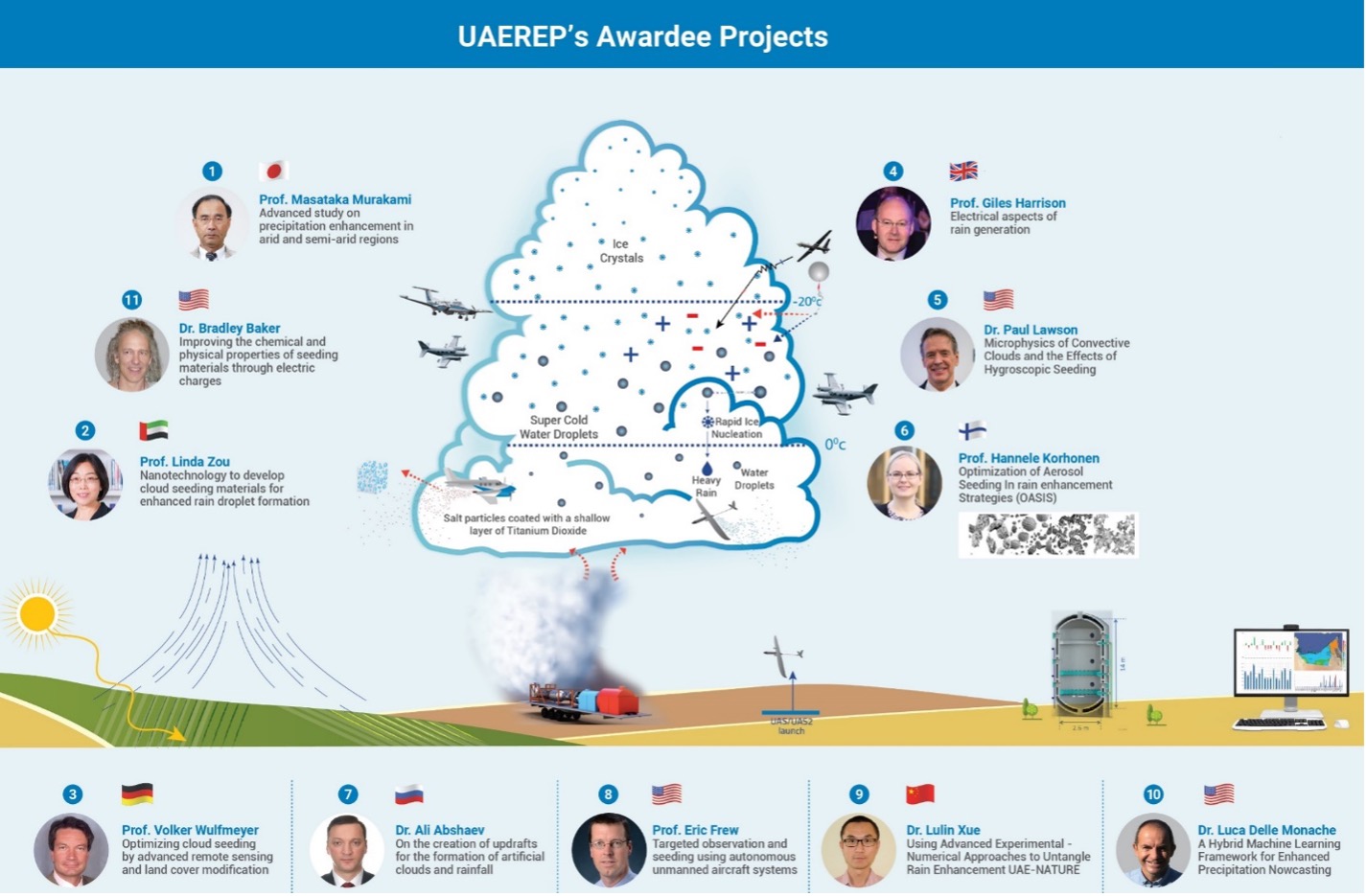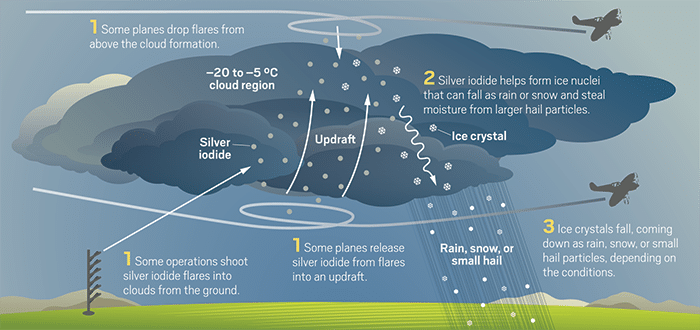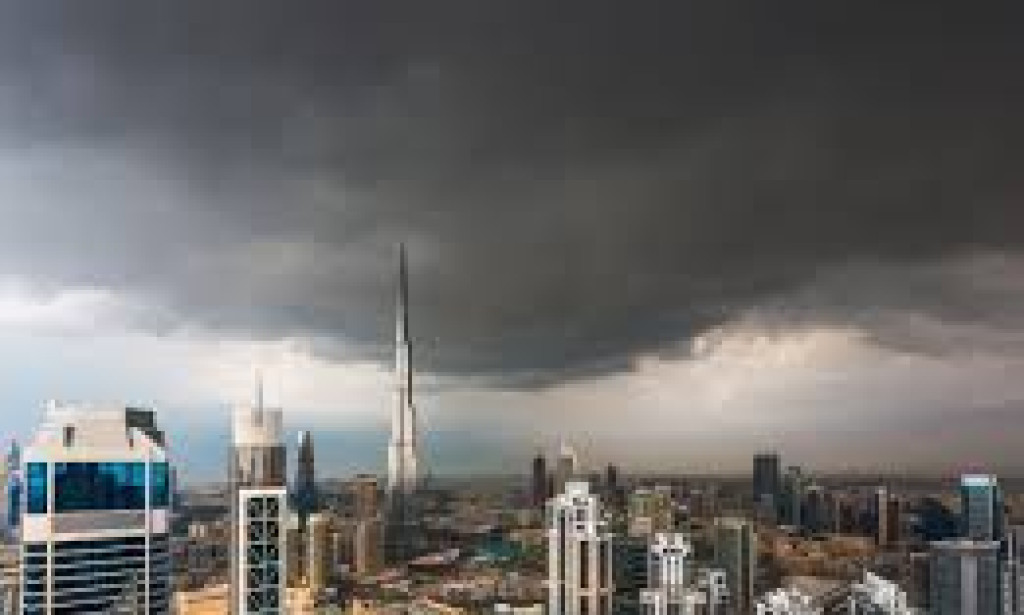 Tuesday's torrents of rainfall caused sections of Dubai to flood and transformed roads into rivers, temporarily closing the second-busiest airport in the world. The question of whether the cloud-seeding program of the United Arab Emirates was to blame for this calamity was raised by the flood of water. According to CNN reports, cloud seeding was not the cause of the rain, according to officials at the nation's National Center of Meteorology. The idea of "cloud seeding" modifies the weather to extract more precipitation or snow from clouds than would otherwise happen. Droplets of cloud don't just appear. The water that collects on the side of a cold glass on a hot day is a suitable surface for the moisture to condense.
Tuesday's torrents of rainfall caused sections of Dubai to flood and transformed roads into rivers, temporarily closing the second-busiest airport in the world. The question of whether the cloud-seeding program of the United Arab Emirates was to blame for this calamity was raised by the flood of water. According to CNN reports, cloud seeding was not the cause of the rain, according to officials at the nation's National Center of Meteorology. The idea of "cloud seeding" modifies the weather to extract more precipitation or snow from clouds than would otherwise happen. Droplets of cloud don't just appear. The water that collects on the side of a cold glass on a hot day is a suitable surface for the moisture to condense.  Condensation nuclei are tiny particles found in clouds - similar to the condensation that builds up on a cold glass's side on a hot day. Condensation nuclei are little air particles that moisture can adhere to in clouds. More of those particles enter the atmosphere through cloud seeding. The idea is to create more water or ice droplets by injecting tiny particles, such as silver iodide, into already-formed clouds. When enough droplets in a cloud combine, they become heavy and descend to Earth as snow or rain. The natural microscopic particles that cause clouds to condense and release their moisture are usually dust and dirt. Theoretically, silver iodide might have the same function. Here are 10 Countries that have tried cloud seeding:
Condensation nuclei are tiny particles found in clouds - similar to the condensation that builds up on a cold glass's side on a hot day. Condensation nuclei are little air particles that moisture can adhere to in clouds. More of those particles enter the atmosphere through cloud seeding. The idea is to create more water or ice droplets by injecting tiny particles, such as silver iodide, into already-formed clouds. When enough droplets in a cloud combine, they become heavy and descend to Earth as snow or rain. The natural microscopic particles that cause clouds to condense and release their moisture are usually dust and dirt. Theoretically, silver iodide might have the same function. Here are 10 Countries that have tried cloud seeding:
United States of America (USA): Since the early 1960s, some weather modification research programs have been funded by two government agencies: the National Oceanic and Atmospheric Administration (NOAA; Department of Commerce) and the United States Bureau of Reclamation (Reclamation; Department of the Interior). Project Stormfury was the US military's attempt in the 1960s to alter storms in the Atlantic basin using cloud seeding. Irving P. Krick and Associates of Palm Springs, California, was one private company that offered to perform weather manipulation in the 1970s (cloud seeding from the ground using silver iodide flares). In 1972, Oklahoma State University hired them to carry out a seeding project in the Lake Carl Blackwell basin to enhance warm cloud rainfall.
Spain: The Precipitation Enhancement Project (PEP), carried out in Spain in 1979 under the direction of the Government of Spain and other member states of the World Meteorological Organization,[37] produced inconclusive results, most likely because of problems with location selection.
Vietnam: The U.S.U.S.itary's Operation Popeye cloud-seeded silver iodide from 1967 to 1972 to prolong the monsoon season over North Vietnam, focusing on the Ho Chi Minh Trail. In the targeted locations, the operation prolonged the monsoon season by an average of 30 to 45 days.[35] To "make mud, not war," the 54th Weather Reconnaissance Squadron conducted the mission.
Australia: Between 1947 and the beginning of the 1960s, the Commonwealth Scientific and Industrial Research Organization (CSIRO) carried out significant trials: CSIRO scientists placed dry ice into the summits of cumulus clouds between 1947 and 1952. When the technique was used in icy clouds, it consistently produced rain that would not have otherwise fallen. 1953–1956: In South Australia, Queensland, and other states, CSIRO conducted comparable experiments. Silver iodide generators in the air and on the ground were utilized in the experiments. Cloud seeding in the late 1950s and early 1960s in the New England District of New South Wales, the Snowy Mountains, the Cape York Peninsula in Queensland, and the Warragamba catchment area west of Sydney. Throughout the experiment, only the trial carried out in the Snowy Mountains resulted in statistically significant increases in rainfall.
Tasmania: In the early 1960s, Hydro Tasmania (the Hydro Electric Commission) experimented with cloud seeding over lake catchments in central Tasmania to investigate if their electricity-producing dams could be kept at high water levels. One location where cloud seeding worked incredibly well was Tasmania. There have been no trials since several were conducted between 1964 and 2005 and 2009 and 2016. Hydro Tasmania collected soil and water survey samples as well. They discovered minute trace amounts of the substances used for cloud seeding, like silver iodine, and concluded the practice had no harmful environmental effects.
China: The People's Republic of China is home to the most extensive cloud seeding system. They think launching silver iodide rockets into the sky where rain is wanted improves the amount of rain over several progressively parched locations, including Beijing, the nation's capital. Even neighboring regions accuse one another of "stealing rain" through cloud seeding, which leads to political unrest.[44] Before the 2008 Olympic Games in Beijing, China employed cloud seeding to ensure a dry Olympic season.[45] China also shot iodide sticks over Beijing in February 2009 and increased snowfall in other northern Chinese regions to create artificial snowfall after four months of drought.

India: The Tamil Nadu government in India carried out cloud seeding operations in 1983, 1984–1987, and 1993–1994 due to a severe drought.[48] The Karnataka government started cloud seeding in 2003 and 2004. In Maharashtra, Weather Modification Inc., a US-based company, also carried out cloud seeding activities that year.[49] Srishti Aviation is a corporation that uses two Cessna 340 aircraft for cloud seeding in air defense operations. The meteorologist at the radar facility on the ground designates the pilots to fly into the cloud that contains a high concentration of liquid water that has been supercooled. The airplane will locate the height at which a temperature of roughly -5 °C is experienced. The seeding agent is most active at this height.
United Arab Emirates: The government of the United Arab Emirates uses a weather modification method called cloud seeding to alleviate the nation's water problems. Another name for cloud seeding is artificial precipitation or rain-making.[56] Among the first nations in the Persian Gulf to use cloud seeding technology is the United Arab Emirates. Scientists in the United Arab Emirates employ cloud seeding technology to mitigate the nation's significant heat-related water scarcity.[57] They regularly monitor the nation's atmosphere with weather radars.[58] Forecasters and scientists have estimated that cloud seeding operations can enhance rainfall by 30-35% percent in a clear atmosphere and up to 10-15% in a more humid atmosphere.
Malaysia: 1988 saw the first cloud seeding in Malaysia, where it was employed to suppress forest fires, minimize the effects of haze, and fill dams. Since the haze started in early August 2015, cloud seeding has been done daily in Malaysia. The Johor Water Regulatory Body aims to generate rain over dams where the water level is dangerously low. Their operations center is Senai Airport WMKJ, and they fly a Cessna 340 equipped with tubes of iodized salt.
Russia: The Soviet Union developed the An-30M Sky Cleaner, a specially modified Antonov An-30 aerial survey aircraft with eight solid carbon dioxide containers in the cargo compartment and external pods holding meteorological cartridges that could be fired into clouds. An-26 is currently employed for cloud seeding as well. President Putin stated that air force jets had been sent to seed approaching clouds so that rain would fall over Finland during the July 2006 G8 Summit in St. Petersburg. Still, the peak was soaked with rain. In Moscow, the Russian Air Force tried seeding clouds with bags of cement on June 17, 2008. One of the bags did not pulverize and went through the roof of a house.
Morocco and Niger: Cloud seeding is also utilized nationally in Niger. The Moroccan government launched the 'Al-Ghait' cloud seeding program in 1985.


You must be logged in to post a comment.